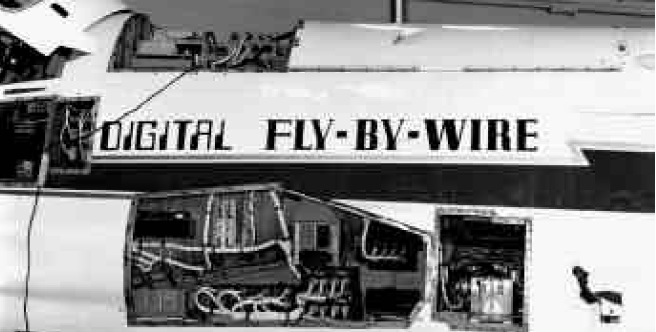 Many people think that the technology of "fly-by-wire", which allows planes to be digitally controlled by a computer, would not have existed without Apollo, and that it was the same computer which was in the lunar module which controlled the first planes using this technology. In fact, this is a myth, the technology of fly-by-wire owes nothing to Apollo, and would have existed without Apollo. This part is intended to break this myth. The computer of Apollo never controlled an airplane, at least alone. This part is based on the book "Computers take flight" of Tomayko, of which it quotes numerous excerpts. Link to the book of Tomayko |
In fact, there were several problems about the use of the computer of Apollo in an airplane. The first one is the cooling system of the computer. They say this about the way the computer of Apollo had to be cooled: "The main problem with using the Apollo Guidance computer and its associated systems was that it needed active cooling while it was running. It was not designed to be air cooled, so the computer and the cooling system had to share space. The F-8 had a good sized avionics bay behind the cockpit and above the gun bays." |
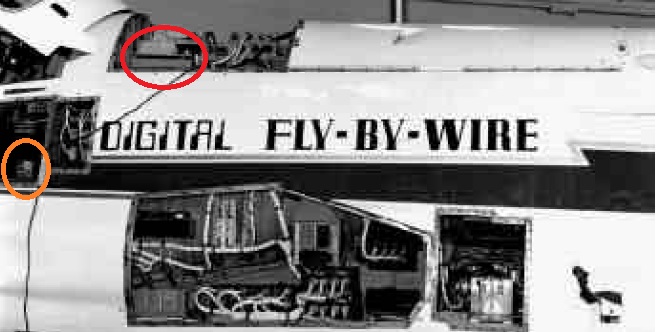 The computer of Apollo and its DSKY unit had be put in particular inconvenient places in the F-8. The computer itself (circled in red) was placed on top of the fuselage, just behind the cockpit, and the DSKY unit (circled in orange) was placed in the gun bay, which means that it was not easily accessible to the pilot. We can even see the cable which connects them, which runs on the outer side of the fuselage, which is an heresy! |
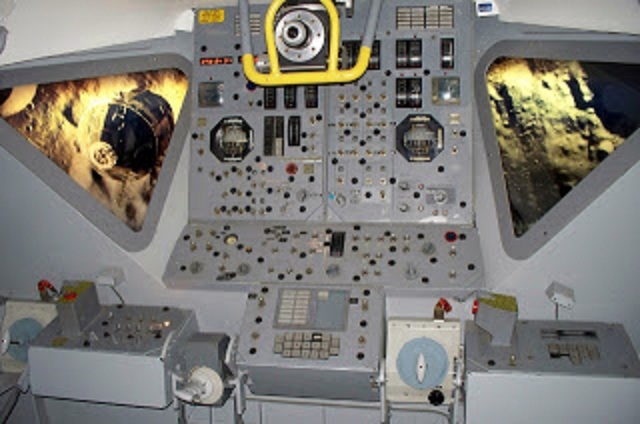 And, while the DSKY unit was on the center of the command panel of the lunar module... |
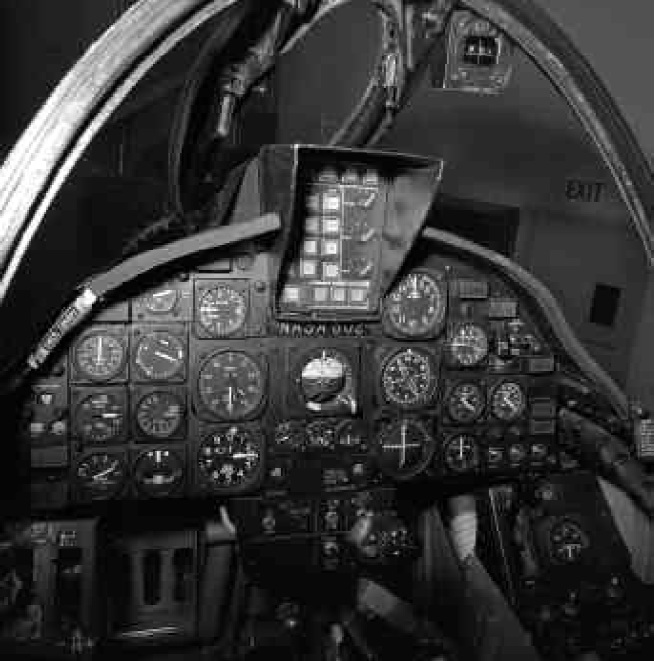 ...What the pilot of the F-8 had in front of him was not the DSKY unit, but a mode control panel, much more convenient to use than the DSKY. |
Logically, the software controlling the plane should have been woven in the core rope memory, for it was that way that the lunar module was controlled. But it would have meant reweaving the rope memory each time a modification had to be made, which was out of question. This is confirmed by this excerpt: "The hardware in the Iron Bird meant that the software would be exercised in an aircraft before shipping it to Raytheon for Rope Manufacture." |
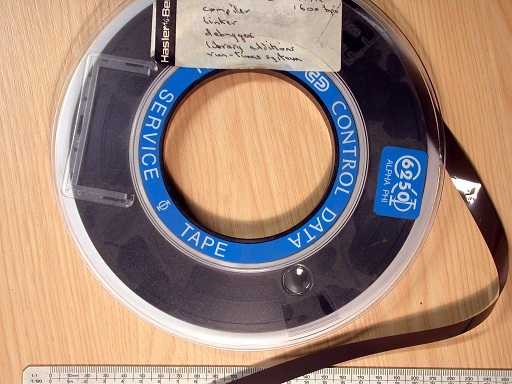 There were so many modifications to make, that the only possible way was to test them in erasable memory and not fixed memory. This is confirmed by this excerpt: "A flight-test program needs flexibility, so putting everything in rope would be as bad as the Sperry analog components Wilt Lock struggled with. Therefore, before every flight, the KSTART software would be put in the erasable memory." And the KSTART program was loaded from tape, as confirmed by this excerpt: "Once verified in the simulators, KSTART was recorded on Mylar tape for final loading in the computer." So, the fly-by-wire was working in a very different way from the lunar module, from the software was loaded from tape in the fly-by-wire tests, while it entirely was in the rope memory for the lunar module. They say that, in the KSTART program, there were data and some programs, but also branch addresses to programs residing in the rope memory. |
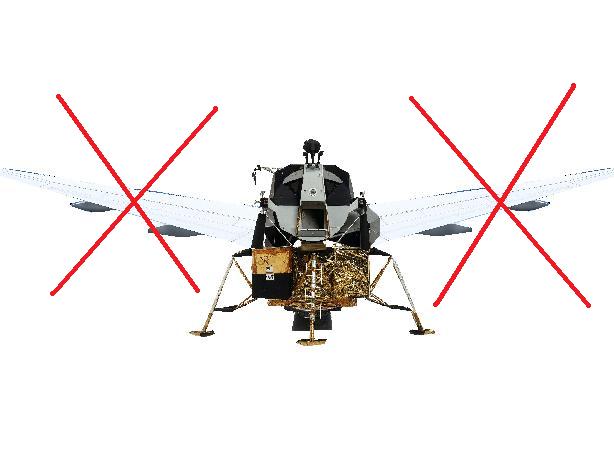 But the lunar module could not behave like a plane, for it had no wings. |
The way the lunar module is controlled is very different from the way a plane is controlled. The plane controls its attitude in a passive way, using the natural action of air, whereas the lunar module controls its attitude in an active way with the force created by its engines. The plane also counters the earth gravity with the action of air, whereas the lunar module counters the lunar gravity with its engine (also with the centrifugal force if it goes fast enough). The force exerted by the plane's engines counters the drag created by air when the plane flies fast; if the plane was stopping countering the drag, its horizontal speed would slow down (and so would the lift which allows to carry it); in the void of space, the lunar module does not have to exert a force to maintain a horizontal speed; it is to slow it down that it has to exert a force. All this shows that controlling the lunar module in the void of space is very different from controlling a plane in earth's atmosphere, and that the programs which allow to control the lunar module cannot be used to control an airplane. It means that new programs had to be developed to control a plane by digital fly-by-wire. |
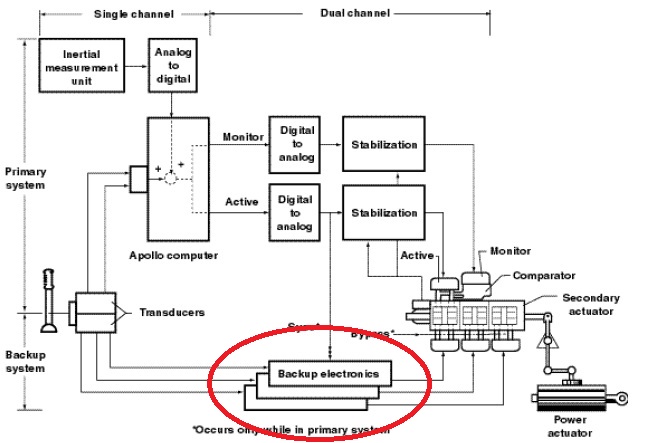 So, you are going to wonder: In the initial tests, there was an Apollo computer aboard the F-8, and the F-8 flew with it. So, it would mean that the AGC was however able to efficiently control the F-8 despite all I said? The answer is simple: The AGC was not controlling the plane alone, it was doubled with analog computers (circled in red) which could relay it in case of problem on the AGC...which was meaning quite fast, in view of the flaws of the AGC. |
Indeed, the AGC had some particularities which were rather annoying, as this excerpt shows: "A nervous flight director received assurances from the computer specialists in a room adjacent to Mission Control that the restarts, though irritating, were normal. Draper wanted to allow three restarts in the F-8 before the digital channel was declared failed. As it turned out, this could take up to one second, which was extremely long for a high-speed airplane. Thus, the requirement was changed; Any one failed restart would cause a switchover to the Backup Control system." |
Given the frequency of the AGC's restarts, this was meaning that it was not long before the backup system would take the control of the plane, and that the plane would be controlled by the analog computers and not the AGC itself. |
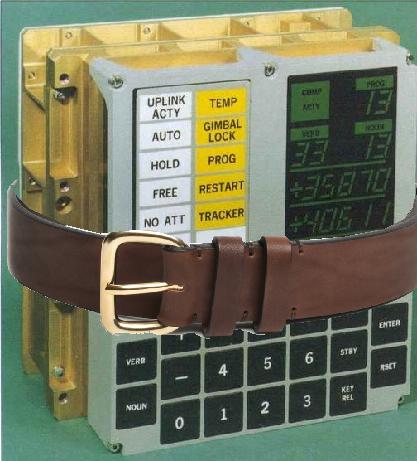 Another flaw of the AGC is that it had limitations that the backup system did not have: "For the first time, Center engineers discovered that the design of the Apollo inertial measurement unit would limit the F-8 to a maximum of 70-Degrees-per-second roll rate as well as a 70 degree pitch attitude." One reason more to use the backup system rather than the AGC. |
 Now, the final goal of the tests was to have the plane exclusively controlled digitally without the help of the analog computers. |
But how could the engineers conceive a working fly-by-wire system controlled by a computer which was nothing but a joke, with a delirious operating system... |
..And not even a working memory! |
 So the objective of the engineers was to gain as much time as possible, by creating repetitive incidents, till the technology had progressed enough to have a reliable compact working computer able to make the plane fly with a normal digital fly-by-wire system. And then comes a long list of incidents, some quite funny. |
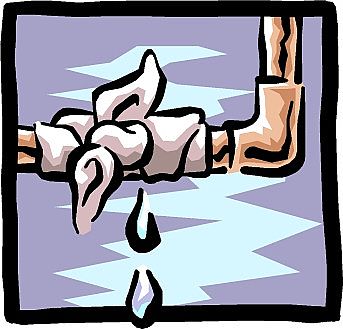 You can't find such a history of repetitive incidents in aircraft tests, it is like a fatality was surrounding these tests. Let's start the fun: "When Krier started his takeoff roll, he immediately had an electrical power failure and had to abort. He cleared the runway and shut down. After towing the aircraft to the ramp, the ground crew opened the access hatch to the generator. There was lubrification oil pooled in the gear housing." Wouldn't have they helped the lubrification oil to pool in the gear housing? |
Another "incident": "An increasingly noticeable aileron oscillation in both ailerons caused the engineers to terminate the pre-flight." Imagine if there was a such oscillation in a plane you take? Would you feel reassured? |
Another humorous incident: "I have some good news and some bad news. The good news first: The digital system and the electrical system are OK". Peterson added "What's the bad news?" Krier replied: "I have a flat tire!". |
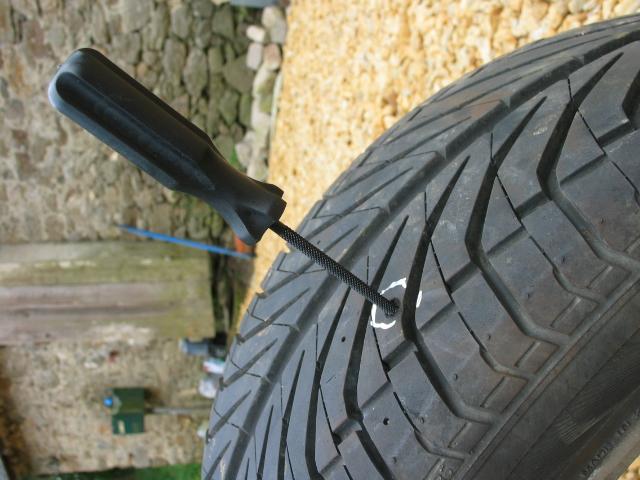 Did they help this tire to get flat? |
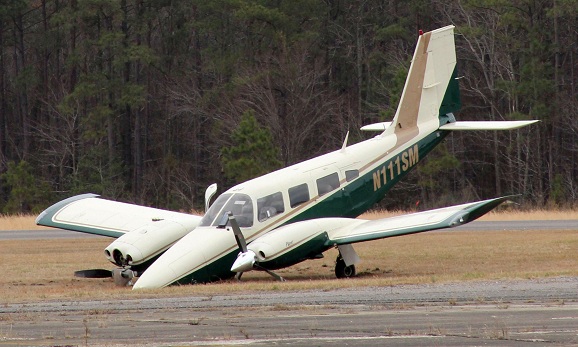 Happily, they had experienced pilots to control the plane when they were creating these incidents: "It was better to have an experienced pilot like Mc Murtry on board when a power-control hydraulic tube burst, causing an emergency landing." |
The AGC proving its power: "He tried to increase to 400 knots, but it proved too fast for the system as it was configured." |
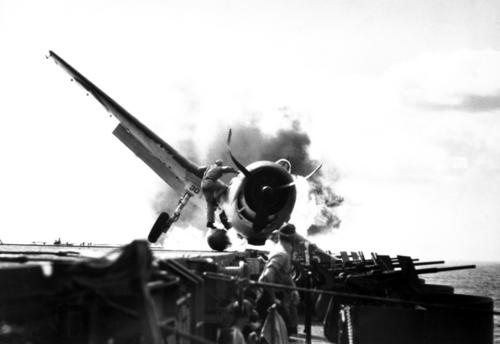 The AGC obviously had a total control of the plane: "Krier said the touchdown took place in considerable side drift and under marginal control. Privately he said he was essentially out of control when the wheels touched the runaway." What would it have been if the AGC had had no control of the plane? |
And the commands were responding perfectly when controlled by the AGC: "On the 15th, Krier tried out partnering again with an F-104. The roll axis remained troublesome. There was a noticeable lag between stick movement and aircraft movement." |
 When they were not creating a mechanical incident, they were creating a software one: "The only flight in February aborted due to an error in loading the KSTART tape which caused an infinite loop-the software was stuck repeating the same few instructions over and over and could not progress." |
When there was a problem in the flight, they were taking all their time to analyze the problem; there was no hurry: "On 6 April 1973, Mc Murtry and Krier flew a two-flight sequence that revealed anomalies in the digital flight-control system. It took nearly three weeks for engineers to complete the analysis that explained what happened and why." |
The AGC was extremely reliable, as this excerpt shows: "When he switched off the telemetry master switch, the ailerons moved to an asymmetrical position that would cause a roll in flight. The crew chief asked McMurtry to cycle the stick, and the control system continuously generated a hard left roll signal....On 16 April, a taxi test confirmed their suspicions. The telemetry master switch had little to do with the problem. The answer lay in software." |
In fact, they give a completely delirious explanation: The roll rate would use an integrator, and this integrator would have a bias that the software would systematically subtract from its output; as this integrator was currently disabled, the software would have been subtracting the integrator bias to an inexistent null output, and this is this integrator bias which would then have been applied to the aileron. |
This explanation is not to be taken seriously, but considered a joke. |
 The backup system saved a desperate situation in the last moment, that the AGC could no more control, as this excerpt shows: "Everything was all right until three seconds before touchdown, when the RRC mode suddenly switched to direct. Krier had to make a lot more stick inputs in direct mode, exacerbated by a 35-knot wind. These rapid inputs reduced the hydraulic pressure in both power-control channels so much the entire system downmoded to the BCS as the wheels touched the runaway." |
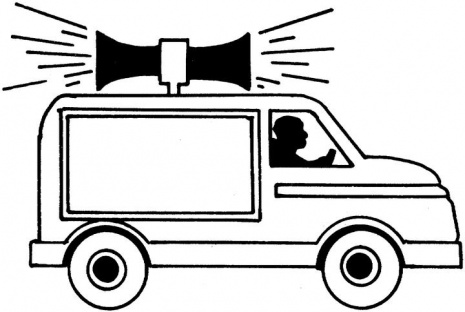 "downmoding" is to be interpreted as "saving the situation". |
 It seems that the flight test engineers had a very good opinion of the ability of the AGC to control a fly-by-wire system, as this excerpt shows: "As they got into their T-38 for the flight back to Edwards, the F-16 project pilot escorting them asked for informal evaluation. They told him that the system had real problems." |
Real problems? No shit! Who would have thought! LOL! |
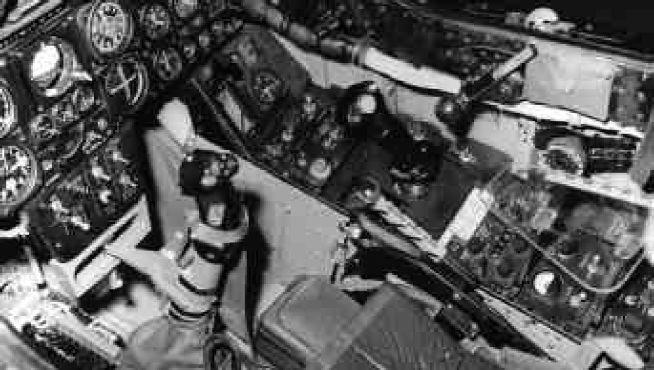 They put a side-stick in the cockpit. This one proved to be very helpful, easy to use, and was responding very well. Everyone praised this side-stick and found it was a real improvement. So, at least something that the AGC could do correctly? Alas, the deception is great when you read this excerpt: "The F-8 installation put the side-stick on the right side of the cockpit, and connected it to the analog BCS only, meaning that Wilt Lock would have primary responsibility to make it work." So, if the side-sick was working so well, it was because it was controlled by an analog computer, and not by the AGC. |
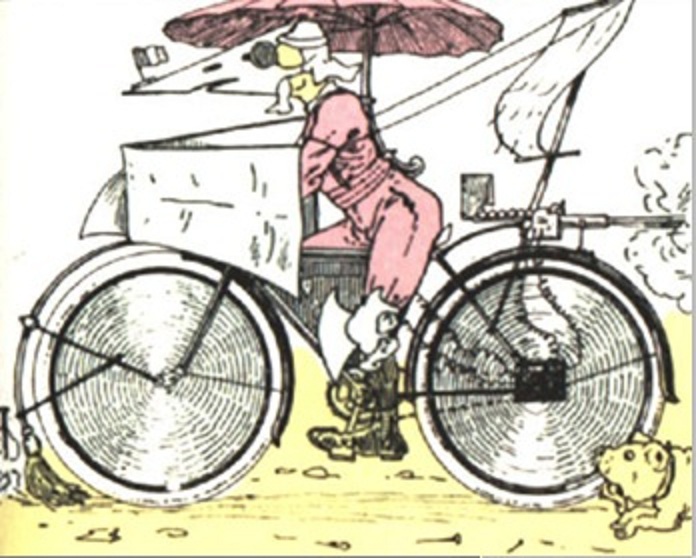 But sure, those who thought it was controlled by the AGC could only have a good opinion of the AGC! |
 In fact the software of the fly-by-wire evolved very importantly, and, even if there had been a part of the Apollo software used in the initial fly-by-wire system (which is not the case), the final software of the fly-by-wire would have been totally different from the initial software, as this excerpt shows: "There also was new software with pioneering redundancy management functions and software for ground control of the airplane in the Remotely Augmented Vehicle Experiments, which meant even more hardware." |
 So, there came a time a computer had to be chosen to make the fly-by-wire software run, that it was considered mature enough to control a plane without the help of analog computers. |
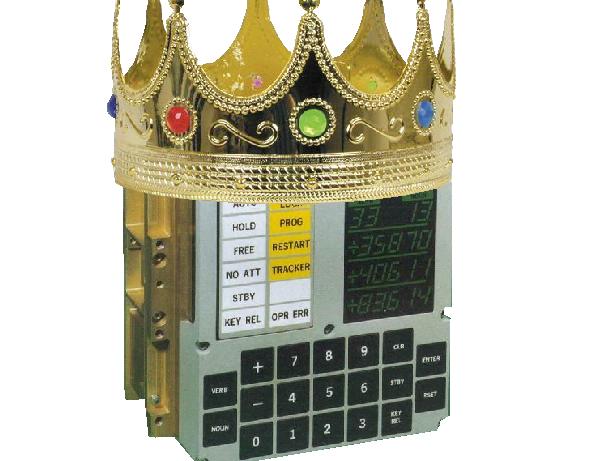 You would have thought that the AGC was on top of the list of the computers which were competing for the glorious task of making the fly-by-wire software entirely control a plane. A revolutionary computer, well in advance on its time, which had an incredible capacity in fixed memory, never seen before. It could only win the competition. |
 In fact, the AGC was not even in the list of the computers competing for making the fly-by-wire software run. |
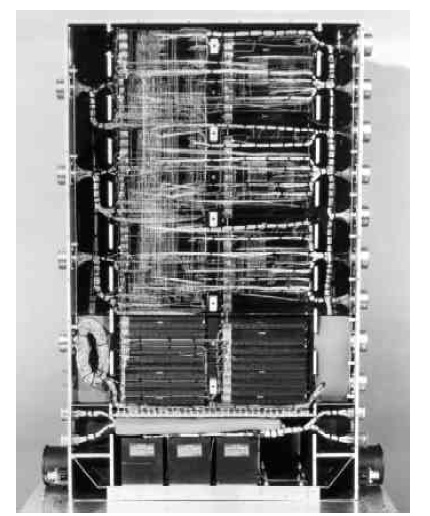 The choice was made between other computers, and it is the AP-101 of IBM which was finally chosen for reasons they explain in this excerpt: "Ken Szalai's notes reveal that the IBM computer had a 32-thousand-word memory, consumed 370 watts of power, and weighed 47.7 pounds. In contrast, the TDY-43M was in two boxes of 35 pounds each, and the SKC-2000 drew 430 watts and weighed 90 pounds." |
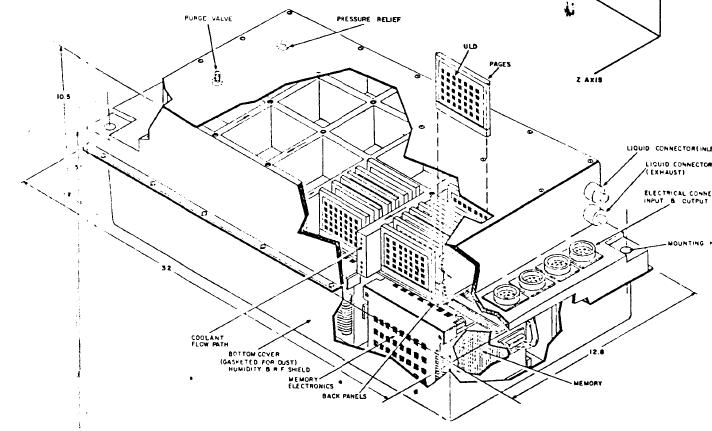 Besides, the IBM computer of the saturn rocket was the only serious embarked computer of the lunar mission. At least, unlike the AGC, it was really working; even if it did not have as much memory as the AGC, its memory was really working. |
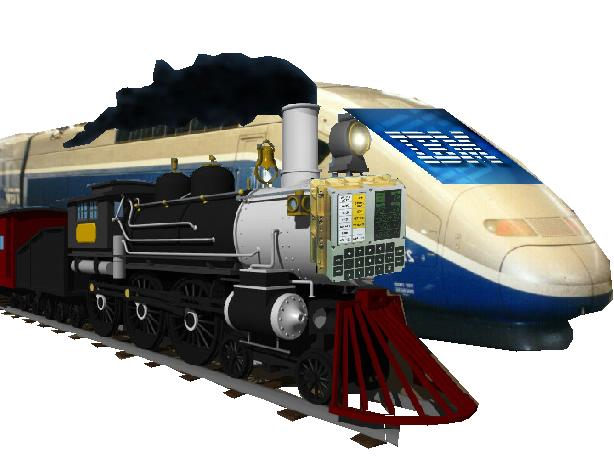 So, how could a joke of a computer have had the least chance compared with a serious really working computer? |
If the F-8 had uniquely been controlled with the AGC, without the analog computers ready to take the relay.... |
..It would have been sure to crash on the ground! |